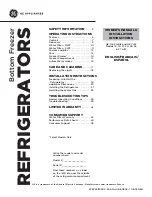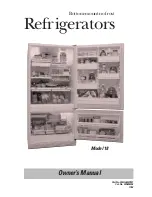
11
To remove and replace the ice bin:
1. Flip up the covering panel.
2. Lift the wire shutoff arm so it clicks into the OFF (up)
position. Ice can still be dispensed, but no more can be
made.
3. Lift up the front of the storage bin and pull the ice bin forward.
4. Replace the bin by pushing it in all the way or the dispenser
will not work. Push the wire shutoff arm down to the ON
position to restart ice production. Make sure the door is
closed tightly.
Style 2
To turn the ice maker on/off:
The on/off switch is located on the top right side of the freezer
compartment.
1. To turn the ice maker on, slide the control to the ON (left)
position.
NOTE: Your ice maker has an automatic shutoff. The ice
maker sensors will automatically stop ice production, but the
control will remain in the ON (left) position.
2. To manually turn the ice maker off, slide the control to the
OFF (right) position.
To remove and replace the ice storage bin:
1. Hold the base of the storage bin with both hands and press
the release button to lift the storage bin up and out.
NOTE: It is not necessary to turn the ice maker control to the
OFF (right) position when removing the storage bin. The
sensor cover (“flipper door”) on the left wall of the freezer
stops the ice maker from producing ice if the door is open or
the storage bin is removed.
2. Replace the storage bin on the door and push down to make
sure it is securely in place.
Clean the ice storage bin
1. Empty the ice container. Use warm water to melt the ice if
necessary.
NOTE: Do not use anything sharp to break up the ice in the
bin or bucket. This can cause damage to the ice container
and the dispenser mechanism.
2. Wash ice bin with a mild detergent, rinse well and dry
thoroughly. Do not use harsh or abrasive cleaners or solvents.
REMEMBER
■
Allow 24 hours to produce the first batch of ice. Allow 3 days
to completely fill ice container.
■
Discard the first three batches of ice produced to avoid
impurities that may be flushed out of the system.
■
The quality of your ice will be only as good as the quality of
the water supplied to your ice maker.
■
Avoid connecting the ice maker to a softened water supply.
Water softener chemicals (such as salt) can damage parts of
the ice maker and lead to poor quality ice. If a softened water
supply cannot be avoided, make sure the water softener is
operating properly and is well maintained.
■
It is normal for the ice cubes to be attached at the corners.
They will break apart easily.
■
For Style 1 ice maker, do not force the wire shutoff arm up or
down.
■
Do not store anything on top of the ice maker or in the ice
storage bin/bucket.
REFRIGERATOR FEATURES
Refrigerator Shelves
The shelves in your refrigerator are adjustable to meet your
individual storage needs.
Storing similar food items together in your refrigerator and
adjusting the shelves to fit different heights of items will make
finding the exact item you want easier. It will also reduce the
amount of time the refrigerator door is open, and save energy.
Shelves and Shelf Frames
To remove and replace a shelf/frame:
1. Remove the shelf/frame by tilting it up at the front and lifting it
out of the shelf supports. Pull shelf straight out.
2. Replace the shelf/frame by guiding the rear shelf hooks into
the shelf supports. Tilt the front of the shelf up until the rear
shelf hooks drop into the shelf supports.
A. Ice maker cover
A
Important information to know about glass shelves
and covers:
Do not clean glass shelves or covers with warm water when
they are cold. Shelves and covers may break if exposed to
sudden temperature changes or impact, such as bumping.
For your protection, tempered glass is designed to shatter
into many small, pebble-size pieces. This is normal. Glass
shelves and covers are heavy. Use special care when
removing them to avoid impact from dropping.












































